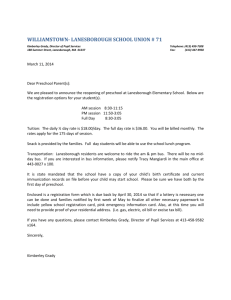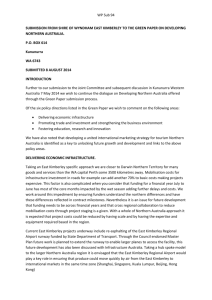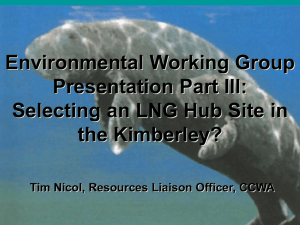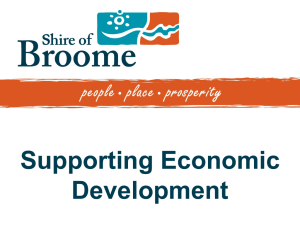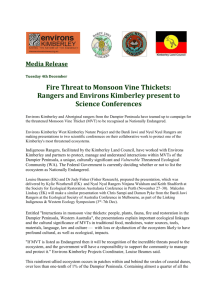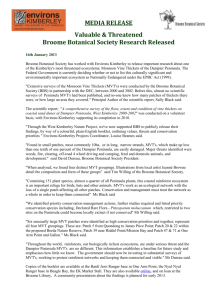DOCX - Department of Industry website
advertisement
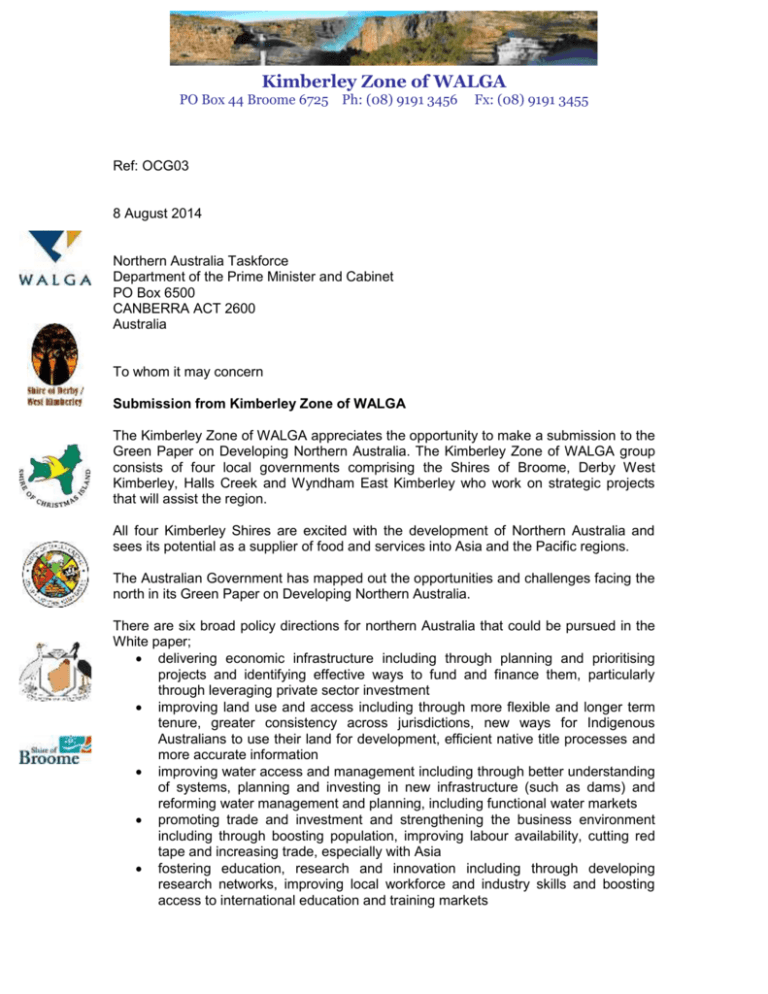
Kimberley Zone of WALGA PO Box 44 Broome 6725 Ph: (08) 9191 3456 Fx: (08) 9191 3455 Ref: OCG03 8 August 2014 Northern Australia Taskforce Department of the Prime Minister and Cabinet PO Box 6500 CANBERRA ACT 2600 Australia To whom it may concern Submission from Kimberley Zone of WALGA The Kimberley Zone of WALGA appreciates the opportunity to make a submission to the Green Paper on Developing Northern Australia. The Kimberley Zone of WALGA group consists of four local governments comprising the Shires of Broome, Derby West Kimberley, Halls Creek and Wyndham East Kimberley who work on strategic projects that will assist the region. All four Kimberley Shires are excited with the development of Northern Australia and sees its potential as a supplier of food and services into Asia and the Pacific regions. The Australian Government has mapped out the opportunities and challenges facing the north in its Green Paper on Developing Northern Australia. There are six broad policy directions for northern Australia that could be pursued in the White paper; delivering economic infrastructure including through planning and prioritising projects and identifying effective ways to fund and finance them, particularly through leveraging private sector investment improving land use and access including through more flexible and longer term tenure, greater consistency across jurisdictions, new ways for Indigenous Australians to use their land for development, efficient native title processes and more accurate information improving water access and management including through better understanding of systems, planning and investing in new infrastructure (such as dams) and reforming water management and planning, including functional water markets promoting trade and investment and strengthening the business environment including through boosting population, improving labour availability, cutting red tape and increasing trade, especially with Asia fostering education, research and innovation including through developing research networks, improving local workforce and industry skills and boosting access to international education and training markets enhancing governance including through better coordinating government and non- government activities, greater engagement with the north and building local capacity. The Kimberley Zone appreciates the opportunity to make this submission to the Northern Australia taskforce. We have taken this opportunity to provide our view and make our recommendation’s on matters we consider are both tangible and offer positive contribution to the discussion on the future of the north. The Kimberley Zone is focused on delivering benefits at a regional level and trust that our recommendations help shape the Government’s policy directions for northern Australia over the next two, five, ten and twenty years. The attached submission details the perspective of the Kimberley Group and incorporates their unique circumstances and geographical issues. Yours sincerely KR Donohoe Secretariat – Kimberley Zone of WALGA. Kimberley Zone of WALGA SUBMISSION TO THE NORTHERN AUSTRALIA TASKFORCE IN RESPONSE TO THE GREEN PAPER ON DEVELOPING NORTHERN AUSTRALIA FRIDAY 8 AUGUST 2014 Table of Contents 1. Submission ..................................................................................................... 5 2. Executive Summary ....................................................................................... 6 3. Background .................................................................................................... 6 3.1 The Region ................................................................................................. 6 3.2 Demographics ............................................................................................. 7 3.3 Employment ................................................................................................ 8 3.4 Economy ..................................................................................................... 8 4 Green Paper Policy Directions ..................................................................... 10 4.1 Delivering Economic Infrastructure ........................................................... 10 4.2 Improving Water Access and Management .............................................. 12 4.3 Promoting Trade and Investment and Strengthening the Business .......... 12 4.4 Fostering Education, Research and Innovation ........................................ 13 5 References ................................................................................................... 14 1. Submission This document is in response to a request by the Northern Australia Taskforce for submissions to the Green Paper on Developing Northern Australia. Request for Submissions The taskforce seeks submissions from interested parties. The Green Paper on Developing Northern Australia sets out four directions with associated questions that can be used to form the basis of submissions; Section A – Profile of Northern Australia o Population and demographics o Natural environment and resources o The economy o Education and health o Infrastructure o Land Section B – Opportunities for Northern Australia o The rise of Asia o Global energy markets o Strategic importance o Technology and innovation o Education, research and skills o Economic diversification o Indigenous economic development o Natural resources and landscapes Section C – Barriers to Development o Remoteness, climate and liveability o Infrastructure o Land access and use o Water Use o Business, trade and investment o Governance Section D – Policy Directions o Delivering economic infrastructure o Improving land use and access o Improving water access and management o Promoting trade and investment and strengthening the business environment o Fostering education, research and innovation o Enhancing governance Otherwise the submission could be formed on the six broad policy directions for northern Australia that could be pursued in the White paper; delivering economic infrastructure improving land use and access improving water access and promoting trade and investment and strengthening the business environment fostering education, research and innovation enhancing governance Kimberley Group Submission This is a group submission on behalf of the Shire of Broome, Shire of Derby West Kimberley, Shire of Halls Creek and Shire of Wyndham East Kimberley referred throughout the submission as the ‘Kimberley Group’. In support of this submission are individual submissions made by the Shire of Broome, Shire of Derby West Kimberley, Shire of Halls Creek and Shire of Wyndham East Kimberley, all lodged separately. All Shires hold strong views on the issues raised by the taskforce and have, to add emphasis, provided these views directly in submissions that are consistent with the groups. The Kimberley Group is appreciative of the opportunity to make a submission that responds to the issues from the perspective of the Kimberley Group and incorporates their unique circumstances and geographical issues. 2. Executive Summary The development of Northern Australia has many challenges with its seasonal variations, geographically remote location, population disbursement and vast untapped resources that require a careful balancing act between development and environmental protection. Given these challenges and opportunities, the Kimberley Group have brought together the shared views of the Local Governments and wish to express these in this submission to the taskforce. The Kimberley Local Governments are already engaged with domestic and international businesses and State and Federal departments across the border and see great value in continuing on progressing these issues in a strategic and long term approach. In particular the Kimberley Group see the need for a major economic development intervention for Northern Australia to achieve tangible outcomes for the region. The following submission outlines the key opportunities and recommendations that should underpin such an approach to the sustainable development of Northern Australia. 3. Background 3.1 The Region The Kimberley region covers an area of 419,558km² which is one sixth of Western Australia’s total land area. It is one of the nine regions of Western Australia and is located in the northern part of the State. The Kimberley is bordered by the Indian Ocean in the west, the Timor Sea to the north, the Great Sandy and Tanami Deserts to the south, and the Northern Territory to the east. The distance from Perth city to the nearest town, Broome, is 2,415km. The distance from Broome to Wyndham is 1055km via the Great Northern Highway. The Kimberley is located north of the Tropic of Capricorn, so the climate is tropical monsoon, defined by a distinct wet season (November to April) and a dry season (May to October). Significant geographic features of the Kimberley include: Most of the northern portion is characterised by savannah style vegetation with mature trees and grasslands. Rivers to the north are commonly lined with paperbarks and pandanus The coast is typically steep cliffs in the north but flatter in the south with both subject to high tides There are no mountains that reach above 1,000 metres The southern end of the Kimberley beyond the Dampier Peninsula is flatter with dry tropical grassland and is used for cattle ranching In parts of the Kimberley such as the valleys of the Ord and Fitzroy Rivers, the soils are useable cracking clays, whilst elsewhere they are lateritic Orthents 3.2 Demographics The relatively small total population of 34,794 persons and correspondingly large geographic area of 419,558km² in the Kimberley region, equates to a population density of 0.08 persons/km² (ABS 2011). This compares with the State population density of 0.89 persons/km² and that of Australia at 2.78 persons/km² in 2011. The median age of the Kimberley population in 2011 was 30 years, compared to the State median age of 36 years. There is a strong Indigenous representation in the Kimberley. The 2011 Census indicated that 40.0% of the total population in the Kimberley were Indigenous people, compared with 3.1% of the population State-wide. According to the 2011 ABS census, Indigenous residents in the Kimberley had a median age of 22 years. It is forecast that the characteristics of the Kimberley population will alter significantly over subsequent generations. From the macro-economic perspective there will be substantial challenges for Local, State and Commonwealth governments in achieving balanced development from economic, cultural and community perspectives. The following summarises the population growth for each Shire in recent years: (ABS 2012) Shire of Broome – 16,524 people in 2012 and of these 51.1% were male and 48.9% were female. Aboriginal and Torres Strait Islander people made up 32% of the population. Shire of Derby West Kimberley – 9,556 people in 2012 and of these 58.9% were male and 41.1% were female. Aboriginal and Torres Strait Islander people made up 53% of the population. Shire of Halls Creek – 4,105 people in 2012 and of these 51.2% were male and 48.8% were female. Aboriginal and Torres Strait Islander people made up 80% of the population. Shire of Wyndham East Kimberley – 8,665 people in 2012 and of these 51.9% were male and 48.1% were female. Aboriginal and Torres Strait Islander people made up 38% of the population. 3.3 Employment The Kimberley region's labour force (total number of people employed and unemployed) has exhibited steady growth increasing from 17,539 in June 2006 to 18,689 in June 2011. The number of employed persons in the Kimberley in June 2011 was 17,176 and unemployed persons were 1,513. The Kimberley region's unemployment rate has been consistently higher than the State's unemployment rate since 2006. The unemployment rate was 8.1% in June 2011, compared to the State rate of 4.2%. 3.4 Economy The Kimberley region’s Gross Regional Product (GRP) was estimated at $3.1 billion in 2010-2011. The top five industries in terms of employment from 2011 Census data were: 1. Education and Training (14.6%) 2. Health Care and Social Assistance (13.0%) 3. Public Administration and Safety (9.3%) 4. Construction (8.5%) 5. Mining (7.2%) Mining The mining industry is the biggest economic contributor to the Kimberley region, with output valued at $1,159 million in 2011. Consistent growth in the Kimberley resources sector over the last 10 years has been a major contributor to the 51 percent increase in Gross Regional Product. That growth is likely to accelerate in the years ahead, primarily driven by the development of the Browse Basin gas resource. Tourism Domestic visitors to the Kimberley region in 2013 were estimated at 320,000 persons and international tourists at 40,000 persons. Tourism expenditure in 2010 was estimated to be $265 million. In 2010 there were an estimated 2,171 people employed directly in servicing the visitor market. The tourism industry is expected to remain a key contributor to economic activity in the Kimberley. The expectation of industry operators is that the region is still moving through the development stage and is yet to achieve its full potential. Agriculture The value of agricultural commodities has fluctuated over the years. In 1994-95, the value was $71.6 million, gradually increasing to $126.8 million in 2000-01, before declining to $95.9 million in 2003-04. In 2009-10, the gross value of Kimberley agricultural commodities was $195 million. The majority of the Kimberley region’s land area is under pastoral lease, with an estimated 100 cattle stations. The Kimberley is the closest pastoral zone to Australia’s biggest export market, Indonesia. Annual export figures to Indonesia are around 600,000 head of cattle. Approximately 300,000 cattle are exported out of Darwin annually and between 60,000 to 80,000 are exported out of Broome each year. The suspension of the live cattle trade to Indonesia in 2011 had a significant impact on the Kimberley region. The value of cattle disposals from the Region was $160 million in 200910, which made up 82% of the total value of agriculture. Horticulture The Horticulture industry has undergone considerable growth in the East Kimberley region with the 8,000 hectare, $220 million Ord East Kimberley Expansion Project. In 2009-10, the Department of Agriculture and Food Western Australia estimated the total value of horticulture production from the Ord River Irrigation Area to be more than $20 million. Commercial horticultural production in the West Kimberley occurs on a relatively small scale in the Derby and Broome Shires, with only a few large-scale commercial businesses. Most of the crops grown in the Kimberley take advantage of the mild to warm 'winter', when they can be grown "out of season" to other Australian production areas. Aquaculture The total value of aquaculture in the Kimberley region for 2009-10 was $67 million. Pearling is a historic industry operating out of Broome with pearl farms along the Kimberley coast. The Kimberley pearl industry peaked at $91.5 million in 2005-06 and 2006-07, but declined to an estimated $64.1 million in 2009-10. This decline was caused by the Global Financial Crisis in 2008-09 which has significantly impacted this industry and it was reported that during that time at least 50% of the pearling industry was in ‘standby’ mode, awaiting improved economic conditions. 4 Green Paper Policy Directions 4.1 Delivering Economic Infrastructure As with many towns across Northern Australia, the Kimberley has very basic infrastructure such as roads, single lane bridges, airports and ports. Much of the infrastructure was built in the sixties and seventies and much of it at capacity, causing detrimental effects on development across the region. All the critical economic and social infrastructure needs detailed in the following section have been identified in the Kimberley Regional Business Plan and Kimberley Development Commission –Regional Investment Blueprint. Transport Routes Transport routes servicing the public, freight, tourism, mining and agriculture industries are very limited. There are no trains servicing the region, the road network is aging, and vast sections require full reconstruction, the majority of bridges are single lane and ports are very basic. The sealing of the Tanami Road is a priority project for the Kimberley Group. The Tanami Road has 753km of currently unsealed road from Halls Creek to Yuendumu and services interstate freight transport companies, pastoral stations, major mining operations, and gives access to tourism attractions and a number of important indigenous communities. At a strategic level, it provides a potentially important direct route between the Kimberley region and the major centres of south eastern Australia. The upgrade of the Tanami Road will contribute to the delivery of national strategic and economic benefits by: Delivering better governance: At present responsibility for the Tanami Road is spread between the Northern Territory Government and Shire of Halls Creek. The full upgrade will enable the road to be managed in a more effective way. Better use of infrastructure: The upgrade of the Tanami Road will be another important link in the national freight network as it will enable produce to be sent to the south-eastern markets from the Kimberley region as well as reducing the high cost of servicing businesses and communities along the road. Boosting exports: The upgrade of the Tanami Road will increasing the productivity of the export businesses across the Kimberley region by reducing the cost of freight to gateways. Supporting Indigenous communities: improving infrastructure in remote and regional Indigenous communities, and closing the gap in essential infrastructure and services between these and non-Indigenous communities. The upgrading of the Tanami Road to an all weather sealed surface will improve services to the three main indigenous communities along the road – Billiluna, Balgo and Mulan. Supporting rural communities: improving the quality of life and economic prosperity in rural and regional communities. The upgrade of the Tanami Road will help to reduce the high of living due in part to the cost of freight and to improve the viability and vitality of rural and regional communities. Sealing the remaining portion of 89km of the Cape Leveque road will allow greater tourism opportunities for the regional communities and allow unrestricted access to Broome centre, as the wet season currently cuts access. A rail network linking the Kimberley to the Northern Territory will open the region up to export markets, enabling mining and agriculture to capitalise in the region with direct linkage to Asian export through Darwin, NT. A rail network will also reduce freight costs for supplies in and product out and enable operational cost savings through bulk transport. Reconfiguring all single lane bridges to dual lane will have a significant impact on the arterial network. Single lane bridges are a huge road safety issue and safety improvements will make a positive contribution to reducing accidents, injuries and fatalities. It will also lead to more confidence and attractiveness of driving holidays to support growth of tourism. Ports Currently all the Kimberley Ports are at capacity for any future major business development. The Broome, Derby and Wyndham ports all require expansion of their terminals, supply base laydowns, and direct land access routes. Developing the proposed Point Torment deep water port facility will be fundamental to ensuring large scale agricultural and mineral development in the Fitzroy valley. The ability to export large quantities of produce and materials will guarantee investor confidence. The impending diversification and development of new industry in the Kimberley is likely to increase competition for access to infrastructure. Those with bigger pockets (often minerals and Energy) historically win this battle. Guaranteed access to affordable export facilities for rangelands, intensive agriculture and aquaculture will be important for attracting investment to the region to develop these industries further. An effective Port Strategy would look to limit competition between minerals and energy industry from the broader agricultural sector by providing separate and appropriately located facilities. The Derby Wharf is limited in size and capacity to cater for large scale mineral projects. However land and access to support lower scale food production consistent with current and historical use is entirely appropriate. Yet, conversely Broome Port is more suited to cater for the demands of the offshore mineral companies. Appropriate port planning and further direction from government to support private sector investment in all Kimberley ports will assist in further derisking future diversification of the northern economy. The East Kimberley are working with Katherine in the Northern Territory on a freight hub, an inland port to service developing markets in the region. Government support in such an initiative would be invaluable to the area, as links with our northern neighbours who are of closer proximity would ensure Airports-Aerial highway The cost of inter-regional air travel is exorbitant compared to travel along the east coast. The costs are prohibitive for both business and private travel, impacting on the tourism market, impacting families with the higher costs to travel, and impacting all in the region due to the higher costs of business. Airports are at capacity, and incapable of taking larger planes and more carriers, thus market competition is haltered and the ability for major investment in the region such as large scale mineral and gas developments may be stiffened in the future if these facilities are incapable of accommodating the demand. The extension of the Regional East Kimberley Airport runway as identified and supported by Infrastructure Australia will enable significant expansion of the tourist and freight export markets servicing the Ord development. 4.2 Improving Water Access and Management The issue of water access and management is a significant issue for the Kimberley agricultural sector. Water allocation and water licensing currently being undertaken by the States Department of Water has had little input or involvement with local government representatives to ensure that licences that are issued are monitored to ensure that allocations are being used for the benefit of the sector, and are simply not being bought for the purposes of water trading. Looking forward to the next ten years, the Kimberley is not prepared to cater for the increasing demand for cattle. More planning and infrastructure support needs to be granted to pastoralists to invest in pivot irrigation systems, to increase stocking levels in line with predicted demand. Infrastructure gives value to land, adding water you get productivity. The Kimberley Zone would like to see the government develop a long term investment strategy that unlocks the natural resources of the Canning Basin, La Grange and Bidyadanga aquifers and provides secure access to water to promote development. 4.3 Promoting Trade and Investment and Strengthening the Business The Kimberley is located in a strategic position to take advantage of the AsianPacific export markets. By investing in reliable and secure road, rail, port and air links, opportunities for regional supply chains to tap into the export market into Asia will be attainable. Mining is currently the largest economic contributor to the Kimberley region, with tourism and agriculture other major industries. There has been steady growth in these sectors, however each has been severely impacted by the lack of direct arterial routes to access markets to the south east and northern territory. Without a direct route from the Kimberley to South East Australia in particular a reliable Tanami road, or a rail link across the top end from the Kimberley to Darwin an onward to Queensland, industries such as mining and agriculture will continue to be impeded by excessive freight costs, thus reducing operational viability or development. Without direct access to major centres, the ability to export product or minerals is also compromised, thus invariable reduces potential investment to the region. Domestic and international competition by tourism organisations to attract visitors is fierce. The Kimberley region has many unique experiences to offer visitors, yet much of the region is unknown. With marketing support, the regions tourism organisations will have the opportunity to better promote and sell the Kimberley Story, leading to increased visitor numbers, more wealth through local economies and creating further employment and business opportunities. 4.4 Fostering Education, Research and Innovation Universities and Training Institutes in the Kimberley are currently reducing capacity and programs. This is a worrying trend and means that youth who want to go onto further education are prohibited from staying in the Kimberley and must relocate to the capital cities. This has a two fold effect, one that youth may be deterred from higher education all together, thus limiting their ability for employment prospects, the second that business development in the region wont be able to source a local workforce as the skills and training wont be there. There needs to be investment in the Universities and Training Institutes, to grow the capacity, and range of programs that are available. There needs to be more industry sponsorship and partnership, encouraging mineral, agricultural and gas developers to promote training opportunities to locals as part of their community investment in the region. The Kimberley Zone recommends that an Education Centre for Excellence be established in the Kimberley aligning high school, higher education and industry sector resources and expertise to deliver academic, career and leadership opportunities and outcomes for interested students. The curriculum would be rigorous and challenging with students undertaking normal course requirements as well as having the opportunity for extended study and research in their areas of interest. The Education Centre for Excellence initiative aims to strengthen school– university partnerships in order to: improve student education and the capacity of students to enter professions of their choosing immerse students in education environments exhibiting leading professional practice, enabling them to better integrate theory with practice increase the capacity in universities to attract and retain high caliber lecturers demonstrate, develop and share high quality teaching practice increase research capacity of teachers and schools. Higher education is changing rapidly. In the future, institutions of higher education will have to operate more efficiently, focus on providing the kind of high quality education students want and employers demand, and adapt to the flexible learning environments which technology is making possible. The development objective of the Education Centres of Excellence would be to support the recipients to promote regional specialization among participating universities and schools in areas that address regional challenges and strengthen the capacities of these education centres to deliver quality training and applied research. The Centers for Excellence would offer students an online program with in campus-based learning labs, training and research at its sponsored centre’s. Outcomes would include; high school accredited diplomas, university degrees, cadetships etc. These unique hybrid learning environments, which marry onsite and online support, would be staffed by facilitators and lecturers to deliver the intensive course programs. 5 References ABS (2014). National Regional Profile 2007-2011. Australian Bureau of Statistics, Canberra. REIWA (2014). Market Information. Real Estate Institute Western Australia. Kimberley Regional Group (2014). Kimberley Strategic Community Plan 20142024. Kimberley Regional Group (2014). Kimberley Regional Business Plan 20142018. KDC (2014). Kimberley Development Commission –Regional Investment Blueprint. RDA (2013). Regional Plan 2013-2016. Regional Development Australia – Kimberley.

